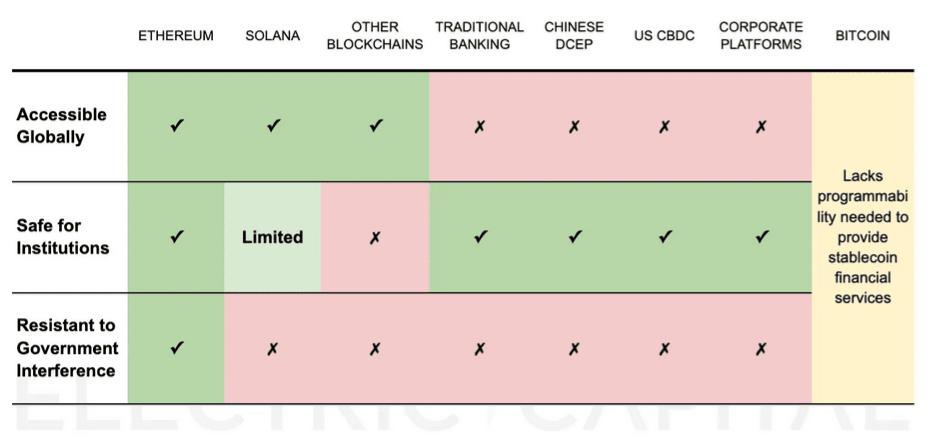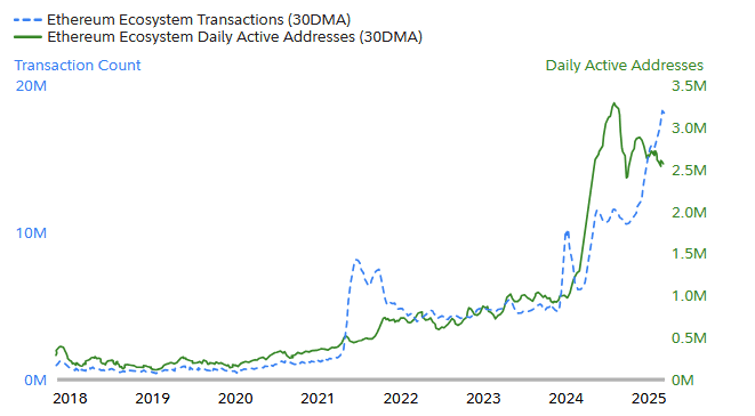
Overview:
Ethereum is increasingly viewed as the reserve asset of the digital dollar economy, with over 54% of stablecoins issued on Ethereum.
Fidelity views Ethereum as a sovereign digital economy, where ETH serves as both a means of value storage and a medium of exchange.
Recent reports suggest that the decline in ETH fees is a strategic move to scale through L2s, laying the groundwork for widespread adoption and future value accumulation.
Last week, Ether (ETH) surged 23%, exceeding Bitcoin's 13% gain and the entire cryptocurrency market's 10% increase. However, Ether's current trading price of $3,400 is still far below its historical peak of $4,855 set in November 2021. While Bitcoin has entered a price discovery phase, if the right arguments are made, Ethereum seems to have even more room for growth.
Every major bull market requires a resonant story. In 2021, Ethereum rebounded with the support of NFTs and DeFi. But now, overpriced JPEGs and decentralized exchanges no longer generate the same market excitement. Instead, Ethereum's appeal lies in its increasingly close integration with traditional finance (TradFi), mainly through its role in stablecoin issuance and tokenization of real-world assets (RWAs).
These evolving use cases are redefining Ethereum as more than just a utility token. It is increasingly viewed as a reserve asset, value storage, and even digital oil.
ETH as a reserve asset
A new report from Electric Capital emphasizes Ethereum's leadership in stablecoin issuance and settlement.
Despite the declining trust in the dollar, global demand for the dollar among individuals and businesses remains strong. Thanks to blockchain, for the first time in history, anyone with internet access can hold and use digital dollars without a bank. Since 2020, the usage of stablecoins has grown 60-fold, now exceeding $200 billion.
These stablecoins are evolving into financial instruments. According to data from The Block, yield-bearing stablecoins currently have a market capitalization exceeding $4 billion, making it the fastest-growing sector where users can earn passive income through stable assets.
Ethereum still dominates in this field, holding over 54% of stablecoins. Electric Capital outlines three key criteria for stablecoin platforms: global accessibility, institutional security, and political neutrality. Ethereum is the only network that consistently meets all three criteria. Tron ranks second with 32%, but as usage increases, its low-cost advantage is being diminished. Meanwhile, Ethereum's fees have decreased due to upgrades and reduced congestion, giving it the opportunity to solidify its position as the core layer of the on-chain dollar economy.

Stablecoin infrastructure comparison. Source: Electric Capital
As this ecosystem develops, ETH's function as a reserve asset is also continuously strengthening. Like government bonds or gold in TradFi, ETH provides collateral, settlement, and yield. It is scarce, non-custodial, reliable, and deeply embedded in DeFi, having supported over $19 billion in loans. Electric Capital believes that ETH can carve out a place in the global $500 trillion value storage market in the long run. It not only possesses Bitcoin's resilience but also offers yield, which is a characteristic favored by American households. Currently, American households hold $32 trillion in dividend stocks but less than $1 trillion in gold.
ETH as a means of value storage
Fidelity's latest report argues that blockchains like Ethereum are best understood as sovereign digital economies rather than Web2 platforms. Like an open economy, Ethereum allows anyone to consume or produce services, while ETH acts as the base currency, coordinating decentralized participants.
Fidelity suggests using a GDP-like framework to measure blockchain economic activity, where "consumption" refers to protocol fees, "government" includes spending by the Ethereum Foundation, "investment" includes changes in ETH staking and DEX liquidity, and "net exports" encompass cross-chain value flows, directed through DePIN to the physical world and through stablecoin issuance to the traditional economy.
Fidelity analysts believe that in this model, Ethereum serves both as a medium of exchange and a means of value storage. As the Ethereum ecosystem expands, demand for ETH is also increasing. So far, trends support this assertion: according to data from Artemis, daily active wallets on Ethereum have now exceeded 2.5 million, and transaction volumes have reached approximately 19 million, a historical high.

Ethereum ecosystem transactions and daily active addresses. Source: Fidelity Source: Fidelity
The Fidelity framework can apply to most blockchains, providing a more direct way to evaluate smart contract platforms for TradFi, just as they understand Bitcoin. The choice to highlight Ethereum likely reflects that it is the most advanced blockchain economy, indicating that more and more institutions recognize Ethereum's potential.
Ethereum as digital oil
Major stakeholders in Ethereum outlined a third perspective in a recent report. The authors argue that Ethereum plays a role in the core of the on-chain economy as a productive, yield-generating commodity. As the global financial system shifts to fully digital, decentralized infrastructure, Ethereum is becoming a core settlement layer, security provider, and reserve asset. Bitcoin embodies the notion of "digital gold," while Ethereum combines value storage with utility, powering computation and decentralized finance while also providing native yield through staking.
The metaphor of "digital oil" reflects Ethereum's multiple roles: it is the fuel for every transaction, can be used as collateral (about one-third of Ethereum's supply secures stablecoins, tokenized assets, and DeFi protocols), and due to design reasons, its issuance remains scarce, with an annual issuance cap of about 1.51%.
The report also mentions Ethereum's fee revenue, which has plummeted from a peak of $82 million during the rebound in 2021 to just $3 million currently. According to the authors of the report, this is not a failure but rather a strategic move to scale. Much like Amazon or Tesla in their early development stages, Ethereum prioritizes long-term adoption over short-term revenue by reducing transaction costs through layer two expansion. While this has temporarily depressed fee revenue, it has expanded Ethereum's total addressable market and will ultimately increase Ethereum's consumption and staking rewards.

Ethereum mainnet and Rollups daily TPS. Source: L2Beat Source: L2Beat
While the fundamental logic of these three reports can apply to other smart contract platforms, each report implies—or outright states—that Ethereum has clear advantages. These advantages often boil down to its "industrial-grade" quality: Ethereum remains the most decentralized blockchain with the safest protocols and the most developed ecosystem in the field.
As Ethereum's appeal to TradFi continues to grow, even its well-known scalability limitations (now alleviated by layer two solutions) no longer seem to be a barrier to institutional adoption. Just as institutional interest drove Bitcoin's rebound in this cycle, Ethereum is now poised to do the same.
This article does not contain investment advice or opinions. Any investment and trading activity carries risks, and readers should conduct their own research before making decisions.





